Indicators to Monitor Progress of the Obesity Route Map
Obesity Route Map
SUMMARY
Obesity Route Map Indicator Framework
This paper presents a set of indicators to monitor progress against the actions we have set out in the Obesity Route Map. The indicator framework has been informed by NHS Health Scotland's Healthy Weight Outcomes logic model and by the Scottish Public Health Networks Obesity Route Map engagement process. A long list of indicators were sent to policy colleagues within the Scottish Government and a range of external experts for comment and to narrow down the list.
Indicators, to monitor implementation and outcomes of Obesity Route Map, are wide-ranging (i.e. covering those areas of policy likely to have an impact on obesity as well as the specific health measures) and include top-line measures as well as interim indicators of progress. Short-term indicators are a mixture of process and output indicators used to measure the outputs and products of the Obesity Route Map e.g. increased understanding of physical activity and diet, more healthy food choices, more options for active travel. Intermediate and long-term indicators are outcome indicators used to measure the ultimate outcomes of the Route Map e.g. from behaviour changes in diet and physical activity to securing goals of healthy weight population and health improvements. The focus of the proposed indicator set is on national measures of progress, but the process of selecting indicators included consideration of measures which could indicate progress at local level and 6 of the final 16 included are measurable at Health Board or Local Authority level. We expect that there will need to be further local development of indicators suitable for local healthy weight strategies to use (although these will not be mandatory).
Obesity Indicator Model
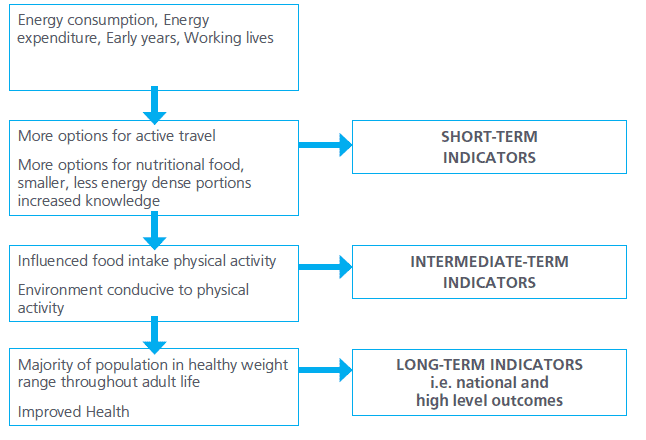
Indicators for Scotland Summary
Long-term Indicators |
|
|---|---|
1 |
Proportion of men and women overweight and obese |
2 |
Proportion of children overweight and obese |
3 |
Prevalence of type 2 diabetes in Scottish population |
Intermediate-term Indicators |
|
|---|---|
4 |
Total and saturated fat: average intake as a percentage of food energy |
5 |
Added sugars ( NMEs): average intake as a percentage of food energy |
6 |
Proportion of adults meeting physical activity guidelines |
7 |
Proportion of adults engaging in sedentary activities |
8 |
Proportion of children engaging in sedentary activities |
9 |
Proportion of children meeting physical activity guidelines |
Short-term Indicators |
|
|---|---|
10 |
Number of businesses securing healthyliving award (and HLA Plus) |
11 |
Volume of sales of soft drinks with added sugar |
12 |
Volume of sales of confectionery, biscuits, cakes and pastries |
13 |
Proportion of population who have tried making positive behaviour change in relation to healthy eating and physical activity |
14 |
Proportion of adults engaging in active travel to work |
15 |
Proportion of children engaging in active travel to school |
16 |
Number of workplaces securing Healthy Working Lives Award |
Headline Indicator 1 |
|---|
Proportion of men and women overweight and obese |
Desired Outcome: Majority of Scotland's adult population in normal weight throughout adult life. Definition: Overweight - BMI 25 to less than 30 Obese - BMI 30 and over Indicator Source: Scottish Health Survey Geography available: National, Health Board (from 2012) Equalities data: Breakdowns by all six equalities groups possible as all are included in the survey, but some won't have large enough sample sizes and may require several years of data to be combined. Age, gender and (possibly) disability breakdowns should be available fairly frequently, but religion, ethnicity and sexual orientation are likely to require more data and therefore be available far less frequently. Date of next update: September 2011 (2010 data) |
Rationale:
The aim of this indicator is to monitor changes in the proportion of Scotland's adult population who are overweight and obese. We will use it to identify any different patterns (and hence need for specific policy focus) amongst men and women of different ages. It is a long-term measure of success of the Obesity Route Map.
Recent Trend
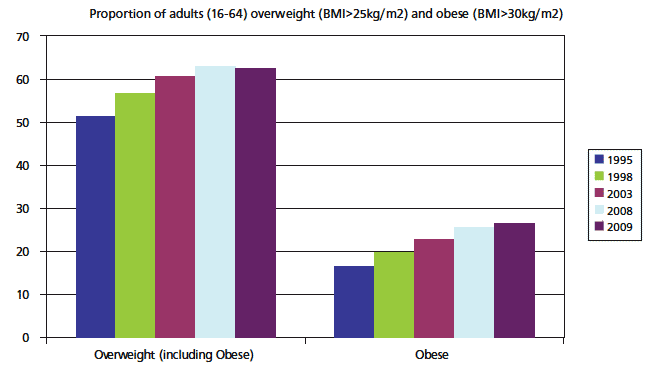
- In 2009 68% of men and 61% of women aged 16 or over were overweight or obese.
- There has been a steady increase in prevalence of overweight and obesity among both sexes since 1995.
- Most recent figures indicate that obesity prevalence increased with age - peaking amongst men aged 55-64 and women aged 65-74.
Drivers:
- Income (men with higher household incomes but women with lower household incomes are likely to be overweight/obese).
- Low physical activity levels.
Headline Indicator 2 |
|---|
Proportion of children overweight and obese |
Desired Outcome: Less children in Scotland overweight and obese. Definition: Overweight - BMI at or above 85th percentile. Obese - BMI at or above 95th percentile. (Based on UK 1990 reference chart cut-offs) Indicator Source: Scottish Health Survey Geography available: National Equalities data: Breakdowns by four equalities groups possible as all are included in the survey (sexual orientation and religion not asked of children), but some won't have large enough sample sizes and may require several years of data to be combined. Age and gender breakdowns are possible on a frequent basis with disability breakdowns less frequent. It is unlikely that the sample size for children will be large enough to breakdown for ethnicity. Date of next update: September 2011 (2010 data) |
Rationale:
The aim of this indicator is to monitor changes in the proportion of Scotland's children who are overweight and obese. We will use it to identify any different patterns (and hence need for specific policy focus) amongst children of different ages. It is a long-term measure of success of the Obesity Route Map.
Recent Trend
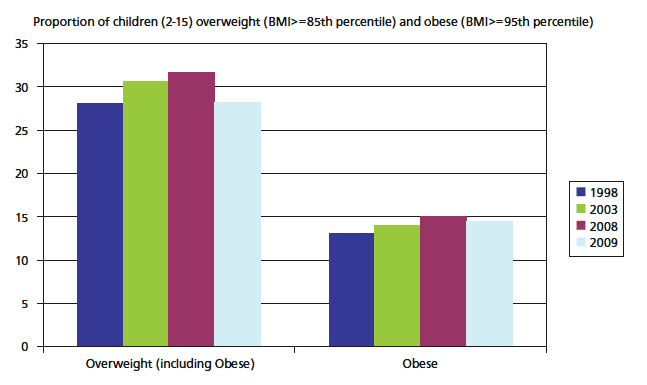
- In 2009 28% of children were overweight or obese.
- Amongst boys, prevalence has fluctuated since 1998 and in 2009 was at 29%; amongst girls the prevalence has been largely stable at around 28%.
- The proportion of children who are overweight or obese increases significantly with age.
- Increasing prevalence of overweight and obesity as children age appears to be driven by higher rates of morbid obesity in older children.
Drivers:
- Parental BMI; children of parents who are of a healthy weight are less likely to be overweight or obese than children of obese parents.
- Area deprivation; children in the most deprived quintile more likely to be obese than children in the least deprived.
Headline Indicator 3 |
|---|
Prevalence of type 2 diabetes in Scottish population |
Desired Outcome: Reduced mortality in obesity related disease. Indicator Source: Scottish Diabetes Survey Equalities: Breakdowns by gender and age are included in the survey. Ethnicity is collected by the survey but subject to variable response rates and may require several years of data to be combined. Breakdowns by religion and disability are not available. Geography available: National, Health Board from 2009 |
Rationale:
The aim of this indicator is to monitor changes in the proportion of Scotland's population who have type 2 diabetes. The Scottish Public Health Observatory estimates that almost half of
type 2 diabetes can be attributed to obesity. Type 2 diabetes becomes much more common with increasing age, although it may also occur in young people. Overweight and obesity are also important risk factors: the risk of type 2 diabetes is around ten times higher among those with a body mass index ( BMI) over 30 compared with those with a BMI under 30.
Recent Trend
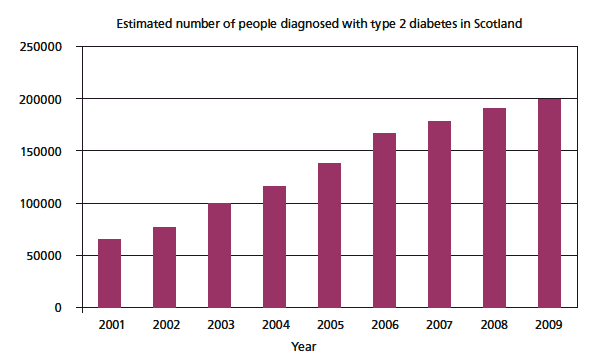
- The most recent Scottish Diabetes Survey (2009) estimates that there were 228,004 people with a diagnosis of diabetes in Scotland at the start of 2010, a crude prevalence of 4.4%.
- Diabetes is an important cause of disability and increases the risk of coronary heart disease and other health problems. It is more common in deprived areas.
- The prevalence of type 2 diabetes is increasing rapidly in Scotland, as in many other countries*.
Drivers:
- Poor diet (specifically excess energy intake), low levels of physical activity and the resulting increase in levels of obesity.
* NB Between 2001 and 2006, the increase in numbers was partly due to improved recording. Since 2007, we are confident the data are a reflection of a real increase in numbers. ( SDS 2009)
Headline Indicator 4 |
|---|
Total and saturated fat: average intake as a percentage of food energy |
Desired Outcome: Reduced energy intake. Relevant Obesity Route Map action: All energy consumption actions. Indicator Source: Food Standards Agency ( FSA) Scotland, Scottish specific analysis of data from the Living Costs and Food Survey. Estimated nutrient intakes are calculated from household food purchases following secondary analysis to convert purchase data to mean per capita consumption and nutrient intakes and to allow meaningful comparisons to be made between years. The FSA Scotland survey of sugar intake among children in Scotland also includes figures for children on total and saturated fatty acids as a percentage of total energy intake. Equalities: Information is collected on differences in food and nutrient intake by deprivation (using the Scottish Index of Multiple Deprivation ( SIMD)). Geography available: Population level information is collected on differences in food and nutrient intake by urban/rural classification. Date of next update: Autumn 2011 (population) and Spring 2012 (children) |
Rationale:
The aim of this indicator is to monitor change in the proportion of the population consuming energy dense foods. Currently people are eating more saturated fat, on average, than is recommended ( FSAS Barton et al, 2010). Rising levels of obesity indicate that energy intakes currently exceed energy requirements ( SHeS). Both these issues raise serious health concerns, particularly in relation to coronary heart disease, high blood pressure, stroke, type 2 diabetes and certain types of cancers ( SHeS).
Recommendations for food and nutrient intake are based on advice from the Committee on Medical Aspects of Food and Nutrition Policy ( COMA) and the Scientific Advisory Committee on Nutrition ( SACN). Published Dietary Reference Values cover a range of intakes for most nutrients and for fat and saturated fat are set as a percentage of daily energy intake for adults.
Recent Trend
Intake of fat and saturated fatty acids in Scottish households, 2001-2008
2001 |
2002 |
2003 |
2004 |
2005 |
2006 |
2007 |
2008 |
|
|---|---|---|---|---|---|---|---|---|
Total Fat |
39.2% |
39.0% |
39.3% |
38.9% |
39.2% |
39.1% |
39.0% |
39.3% |
Saturated Fat |
15.7% |
15.8% |
15.8% |
15.6% |
15.6% |
15.9% |
15.4% |
15.5% |
- In 2008, at a population level the percentage of food energy from total fat remained at around 39%, above the recommendation of no more than 35% and the percentage of food energy from saturated fat remained at 15.5% compared with the recommendation of no more than 11%.
- There have been no changes in total fat or saturated fat as a percentage of energy over the period of 2001 to 2008.
Intake of fat and saturated fatty acids in Scottish children aged 3-16yrs, 2006
Boys |
Girls |
|
|---|---|---|
Total Fat |
32.9% |
33.0% |
Saturated Fat |
13.9% |
13.7% |
- In 2006 mean intakes of total fat as a percentage of food energy for children were lower than the recommended levels (<35%). The mean intake of saturated fatty acids (13.8%) was however above the recommended level of less than 11% food energy.
Drivers:
- Availability, cost, access.
Headline Indicator 5 |
|---|
Added sugars ( NMEs - non-milk extrinsic): average intake as a percentage of food energy |
Desired Outcome: Reduced energy intake. Relevant Obesity Route Map action: All energy consumption actions. Indicator Source: Food Standards Agency ( FSA) Scotland, Scottish specific analysis of population level data from the Living Costs and Food Survey. Food Standards Agency ( FSA) Scotland, Survey of Sugar Intake among children in Scotland. Equalities: Information is collected on differences in food and nutrient intake by deprivation (using the Scottish Index of Multiple Deprivation ( SIMD). Geography available: Population level information is collected on differences in food and nutrient intake by urban/rural classification. Date of next update: Autumn 2011 (population) and Spring 2012 (children) |
Rationale:
The aim of this indicator is to monitor change in the proportion of adults and children consuming energy dense foods. As noted above, rising levels of obesity indicate that energy intakes currently exceed energy requirements with associated health problems.
Recent Trend
Intake of added sugars as percentage of food energy amongst Scottish adults
2001 |
2002 |
2003 |
2004 |
2005 |
2006 |
2007 |
2008 |
|
|---|---|---|---|---|---|---|---|---|
Non-milk extrinsic sugars |
15.6% |
15.8% |
16.2% |
15.7% |
15.4% |
15.2% |
15.1% |
15.1% |
Intake of added sugars as percentage of food energy amongst Scottish children (3-16)
Non-milk extrinsic sugars |
2006 |
|---|---|
Boys |
17.4% |
Girls |
17.4% |
- The percentage of food energy contributed by NMES rose slightly from 2001 to 2003 (from 15.6% to 16.2%) but has steadily fallen to 15.1% in 2008.
- Intakes remain higher than the recommended levels for children (less then 10% of total energy) and for adults (less than 11% of food energy).
- The overall fall in percentage of energy from NMES of 0.5% was statistically significant.
Drivers:
- Availability, cost, access.
Headline Indicator 6 |
|---|
Proportion of adults meeting physical activity guidelines |
Desired Outcome: Increased energy expenditure. Definition: Accumulation of 30 minutes or more of moderate intensity physical activity on 5 days per week. Relevant Obesity Route Map action: All energy expenditure actions. Indicator Source: Scottish Health Survey Geography available: National, Health Board (from 2012) Equalities data: Breakdowns by all six equalities groups possible as all are included in the survey, but some won't have large enough sample sizes and may require several years of data to be combined. Age, gender and (possibly) disability breakdowns should be available fairly frequently, but religion, ethnicity and sexual orientation are likely to require more data and therefore be available far less frequently. Date of next update: September 2011 (2010 data) |
Rationale:
The aim of this indicator is to monitor change in the proportion of adults who meet physical activity guidelines - currently accumulating 30 minutes or more of moderate intensity physical activity on most days of the week.
Recent Trend
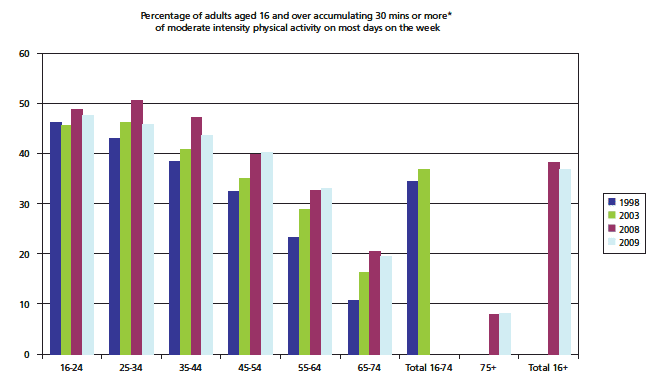
*In 2008 the PA question changed from bouts of 15 minutes or more to bouts of 10 minutes or more to be in line with the recommendation.
- In 2009 37% of adults met the current physical activity recommendations.
- Men were more likely to meet recommended levels than women and the gap was particularly wide among those aged 16-24 where 61% of men compared with 38% of women met the recommended activity level.
- The proportion of adults meeting physical activity recommendations has increased since 1998 for all age groups apart from those aged 16-24 where the proportions have remained static.
Drivers:
- Age and gender: Although more likely than women across all age groups to meet physical activity guidelines, for men physical activity levels decline steadily with age whereas for women the proportion meeting guidelines is relatively stable between the ages of 16 to 54, then declines steeply.
Headline Indicator 7 |
|---|
Proportion of adults engaging in sedentary activities |
Desired Outcome: Increased energy expenditure. Definition: Time spent at a screen on an average day (including weekdays and weekends) excluding time at work. Relevant Obesity Route Map action: Does not map onto specific obesity action but indirectly relates to energy expenditure actions. Indicator Source: Scottish Health Survey Geography available: National Equalities data: Breakdowns by all six equalities groups possible as all are included in the survey, but some won't have large enough sample sizes and may require several years of data to be combined. Age, gender and (possibly) disability breakdowns should be available, but religion, ethnicity and sexual orientation are not likely to be possible as this question is only in the survey every second year and therefore has a smaller sample size. Date of next update: September 2011 (2010 data) - data only available biennially. |
Rationale:
The aim of this indicator is to monitor the proportion of adults engaging in sedentary behaviour such as hours spent sitting at screen on an average day. This does not include time spent at work on a screen.
Recent Trend
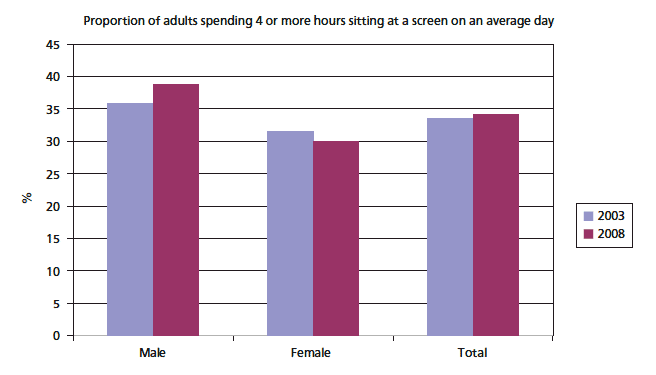
The proportion of men spending 4 or more hours at a screen per day has increased since 2003 from 36% to 39% although this isn't a significant difference.
There was a slight (also insignificant) fall for women from 31% to 30% over the same period.
Drivers:
- Choice of leisure activities.
- Availability of alternatives to screen-based activity.
Headline Indicator 8 |
|---|
Proportion of children engaging in sedentary activities |
Desired Outcome: Increased energy expenditure. Definition: Time spent at a screen on an average day (including weekdays and weekends) excluding time at school. Relevant Obesity Route Map action: Early years actions, specifically less sedentary activities for young children. Indicator Source: Scottish Health Survey Geography available: National Equalities data: Breakdowns by four equalities groups possible as all are included in the survey (sexual orientation and religion not asked of children), but some won't have large enough sample sizes and may require several years of data to be combined. Age and gender are likely to be the only groups with large enough sample size for this indicator due to the question only being asked every second year. Date of next update: September 2011 (2010 data) - data only available biennially. |
Rationale:
The aim of this indicator is to monitor the proportion of children engaging in sedentary behaviour such as hours spent sitting at screen on an average day.
Recent Trend
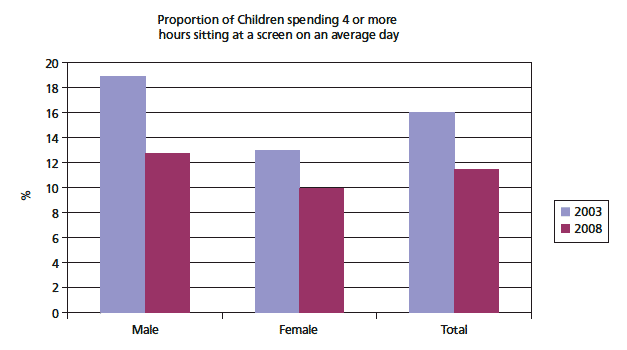
There has been a reduction in the proportion of children spending 4 or more hours at a screen per day - from 16% to 11% between 2003 and 2008. This is mainly driven by boys where figures have fallen from 19% to 13% but there has also been a fall for girls - from 13% to 10%. However, none of these differences are statistically significant.
Drivers:
- Choice of leisure activities.
- Availability of alternatives to screen-based activity.
- Safe outdoor spaces to play.
Headline Indicator 9 |
|---|
Proportion of children meeting physical activity guidelines |
Desired Outcome: Increased energy expenditure. Definition: Accumulating 1 hour or more of moderate intensity physical activity every day of the week. Relevant Obesity Route Map action: Early years actions, specifically less sedentary activities for young children. Indicator Source: Scottish Health Survey Geography available: National Equalities data: Breakdowns by four equalities groups possible as all are included in the survey (sexual orientation and religion not asked of children), but some won't have large enough sample sizes and may require several years of data to be combined. Age and gender breakdowns are possible on a frequent basis with disability breakdowns less frequent. It is unlikely that the sample size for children will be large enough to breakdown for ethnicity. Date of next update: September 2011 (2010 data) |
Rationale:
The aim of this indicator is to monitor the proportion of children (aged 2-15) meeting current physical activity recommendation which is to accumulate 60 minutes or more of moderate intensity physical activity on most days of the week. Although surveys indicate no significant association between children's activity and their BMI, research suggests that focusing on physical activity is important as part of a wider weight management strategy for children.
Recent Trend
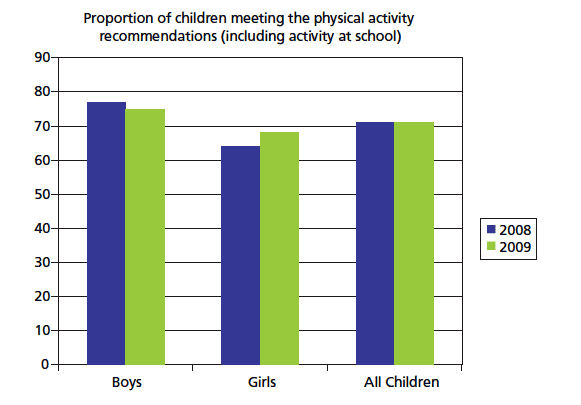
- This question was changed in 2008 to include school-based physical activity. It is possible to look at trends since 1995 excluding school-based activity and this shows the figures fluctuate over time at around 70% of boys and 60% of girls.
- Boys are generally more physically active at all ages but the difference is particularly pronounced in the early teenage years.
- Only 41% of girls aged 13-15 were active for the recommended 60 minutes on every day compared with 70% of boys.
Drivers:
- Availability of safe outdoor places.
- Access to leisure facilities.
Headline Indicator 10 |
|---|
Number of businesses securing healthyliving award (and HLA Plus) |
Desired Outcome: Reduced consumption of high energy food and drink in workplaces. Relevant Obesity Route Map action: Two actions to encourage participation in healthyliving award scheme. Indicator Source: Consumer Focus Scotland Geography available: National Equalities data: Not applicable Date of next update: Annual |
Rationale:
The aim of this indicator is to assess the take-up of healthyliving awards by companies. The healthyliving award, introduced in 2006, rewards catering establishments for serving healthier food and finding ways of helping their customers make better food choices. The award is open to all kinds of catering places - from sandwich shops to staff restaurants - and increasing the number of establishments with this award will play a part in improving diet across Scotland. For all organisations already participating, the healthyliving award plus offers an opportunity to achieve step increases in the required ratio of healthy options to other options on the menus from participating caterers.
Evidence from existing literature suggests a low level of evidence for the effectiveness of consumer targeted incentives but with potentially high levels of population effectiveness. The Scot PHN engagement process for the Route Map assessed the action as having high impact with medium to high effort.
Recent Trend
Number of sites with first term awards
2007 |
198 |
|---|---|
2008 |
243 |
2009 |
245 |
- As at October 2010, there are 833 sites that carry the healthyliving award with 1,535 sites registered for it and working towards it. Of these 281 have achieved the award for a second term (i.e. held award for 4 years).
Drivers:
- Exposure to high energy foods.
Headline Indicator 11 |
|---|
Volume of sales of soft drinks with added sugar |
Desired Outcome: Reduced consumption of high energy food and drink. Relevant Obesity Route Map action: Action to work with the Food Implementation Group to reduce sugar levels and portion sizes. Indicator Source: Food Standards Agency Scotland (Kantar Worldpanel) Geography available: Scotland level only Equalities data: Not applicable Date of next update: Data will be available by June 2011 and updated annually. |
Rationale:
The aim of this indicator is to monitor the volume of sales of soft drinks with added sugar in supermarkets in Scotland.
There is evidence of an association between sugar-sweetened soft drinks and prevalence of obesity and interventions in this area have been shown to be effective.
Drivers:
- Availability and affordability of healthy choices.
Headline Indicator 12 |
|---|
Volume of sales of confectionery, biscuits, cakes and pastries |
Desired Outcome: Reduced consumption of high energy food and drink. Relevant Obesity Route Map action: Action to work with retailers to encourage stocking of smaller and less energy-dense portions, with the the Food Implementation Group to reduce saturated fat and sugar levels. Indicator Source: Food Standards Agency Scotland (Kantar Worldpanel) Geography available: Scotland level only Equalities data: Not applicable Date of next update: Data will be available by June 2011 and updated annually. |
Rationale:
The aim of this indicator is to monitor the sales by volume of confectionery, biscuits, cakes and pastries in supermarkets in Scotland.
There is evidence that obesity is associated with over consumption of energy dense snack foods such as confectionery, biscuits, cakes and pastries. Moderate evidence exists in the literature for interventions aimed at reducing availability and affordability of energy dense foods and with a moderate rating for potential population effectiveness. The Scot PHN engagement process for the Route Map assessed the action as having high impact with medium to high effort.
Drivers:
- Availability and affordability of healthy choices.
Headline Indicator 13 |
|---|
Proportion of population who have tried making positive behaviour change in relation to healthy eating and physical activity |
Desired Outcome: Increased awareness, knowledge, skills and empowerment. Relevant Obesity Route Map action: A better understanding of healthy food for the whole population, and using appropriate social marketing to encourage people to be more active. Indicator Source: Scottish Health Survey (Knowledge, Attitudes and Motivations ( KAM) module) Geography available: National Equalities data: Breakdowns by age, gender and (possibly) disability should be available. Date of next update: Annual update - 2008 and 2009 data published in December 2010 |
Rationale:
The aim of this indicator is to assess levels of awareness of healthy behaviours (in relation to physical activity and eating healthily) amongst the Scottish population, and willingness to sustain such lifestyle changes.
Moderate level of evidence exists in the literature for the effectiveness of mass media activity campaigns and with a high rating for potential population effectiveness. The Scot PHN engagement process for the Route Map assessed the action as having medium to high impact with low to medium effort.
Recent Trend
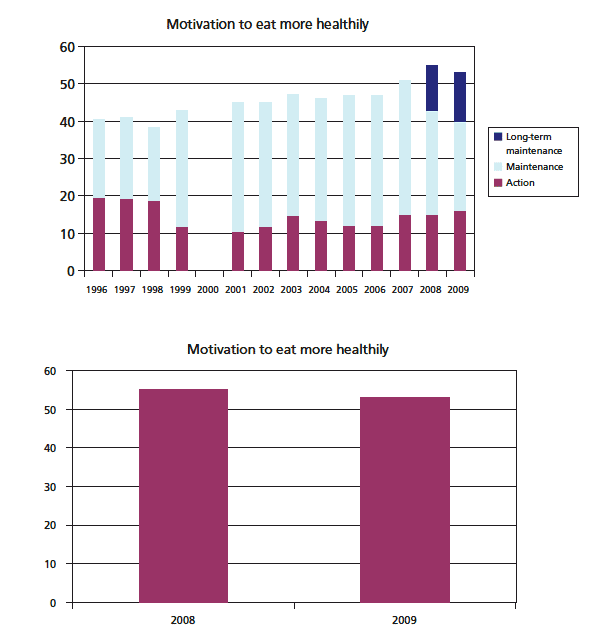
The chart above presents the proportion of adults motivated to eat more healthily in three stages as classified in KAM report: action (the person ate more healthily in previous 12 months but did not maintain their healthier diet), maintenance (the person ate more healthily in previous 12 months and maintained this) and long-term maintenance (the person did not eat more healthily in previous 12 months and no desire to improve diet, but meets the five-a day recommendation). This last category was only created in 2008.
The charts above present the proportion of adults motivated to be more physically active in three stages as classified in KAM report: action (the person increased physical activity levels in the previous 12 months but did not maintain these increased levels), maintenance (the person increased physical activity levels in the previous 12 months and maintained these increased levels) and long-term maintenance (the person was active at the recommended level and did not increase activity levels in the past 12 months or want to increase them further in future). This last category was only created in 2008.
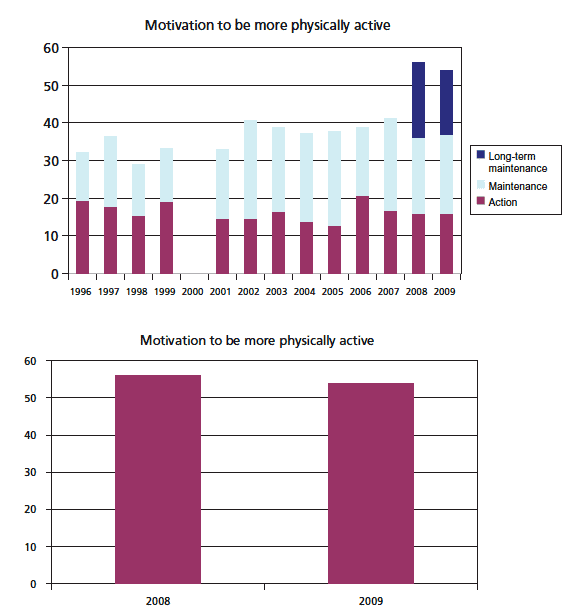
Drivers:
- Knowledge and understanding of healthy choices.
- Availability of opportunities to be more physically active.
Headline Indicator 14 |
|---|
Proportion of adults engaging in active travel to work |
Desrired Outcome: Promotion of active travel. Relevant Obesity Route Map action: Deliver cycle action plan. Indicator Source: Employed adults' (not working at home) usual method of travel to work. Household Transport Bulletin. Scottish Government. Geography available: National, LA every two years Equalities data: Breakdowns by gender, age and disability possible. Date of next update: Information collected annually |
Rationale:
The indicator provides a measure of the extent to which adults are choosing physically active means of travel to work (cycling or walking). The indicator supports actions in the Route Map relating to encouraging employers to support employees to use more active means of travelling to and from work.
Low level of evidence exists in literature for the effectiveness of active travel incentives and facilities with a moderate rating for potential population effectiveness. The Scot PHN engagement process for the Route Map assessed the action as having medium impact with medium to high effort.
Recent Trend
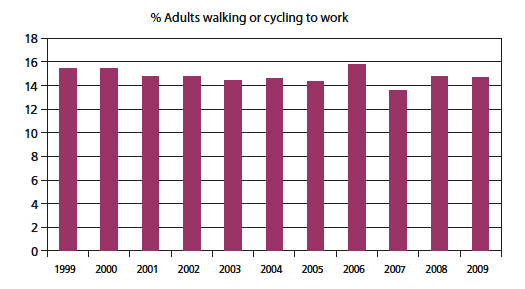
There has been little change in the proportion of adults walking or cycling to work over the last decade with the figures fluctuating around the 15% mark.
Drivers:
- Availability of alternatives.
- Employer incentives.
Headline Indicator 15 |
|---|
Proportion of children engaging in active travel to school |
Desired Outcome: Promotion of active travel. Relevant Obesity Route Map action: Deliver cycle action plan. Indicator Source: Pupils in full-time education at school usual method to travel to school. Household Transport Bulletin. Scottish Government. Geography available: National, LA every two years Equalities data: Breakdowns by gender, age and disability possible. Date of next update: Information collected annually |
Rationale:
This indicator relates to Route Map actions relating to encouraging opportunities for physical activity and sport including safer routes to schools.
Low level of evidence exists in literature for the effectiveness of active travel incentives and facilities with a moderate rating for potential population effectiveness. The Scot PHN engagement process for the Route Map assessed the action as having medium impact with medium to high effort.
Recent Trend
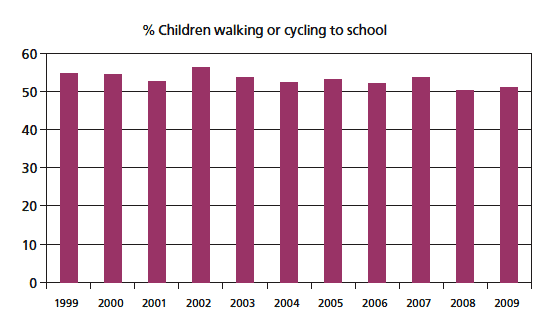
Figures have fluctuated over the last decade with no clear pattern. The latest figure was 51% in 2009.
Drivers:
- Availability of safe routes to schools.
Headline Indicator 16 |
|---|
Number of workplaces securing Healthy Working Lives Award |
Desired Outcome: Promotion of active workplaces. Relevant Obesity Route Map action: Maximise promotion of healthy lives approach in public sector through clear, consistent vision. Indicator Source: Scottish Centre for Healthy Working Lives Geography available: National and Health Board Equalities data: Not applicable Date of next update: Annual |
Rationale:
The aim of this indicator is to assess the take-up of Healthy Working Lives Awards by companies. The indicator will show the level of award (Gold, Silver, Bronze) as well as the number of companies working towards their Bronze award - hence providing both an indication of the general awareness and take-up of the scheme, and the proportion of companies providing the highest level of support.
High level of evidence exists in literature for the effectiveness of multi-component workplace interventions with a low to moderate rating for potential population effectiveness. The Scot PHN engagement process for the Route Map assessed the action as having high impact with low to medium effort.
Recent Trend
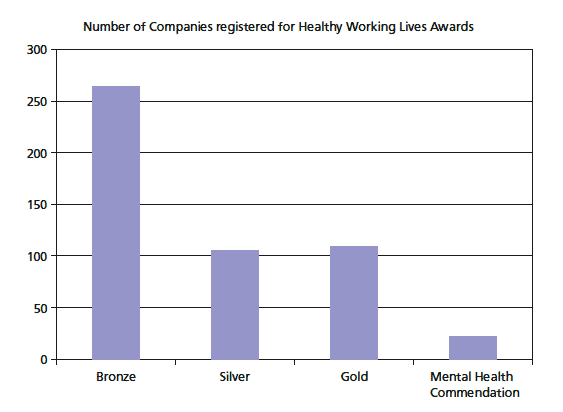
- Currently there are 1,166 organisations who are actively registered for the Healthy Working Lives Award Programme, 666 of whom will be working towards their bronze award.
- 716,815 employees are covered by the Healthy Working Lives Awards.
Drivers:
- Availability and affordability of healthy choices.
There is a problem
Thanks for your feedback